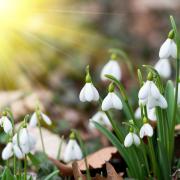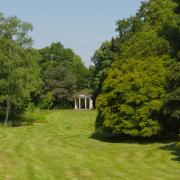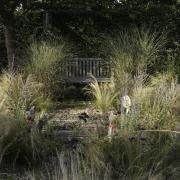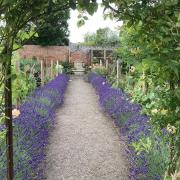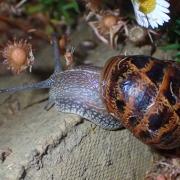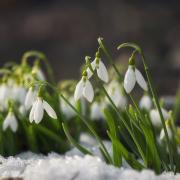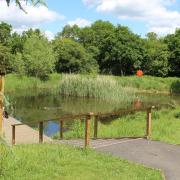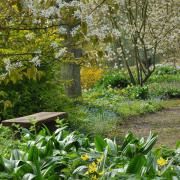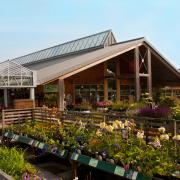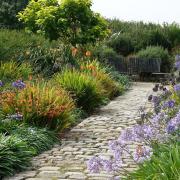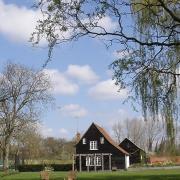A visit to Daws Hall in Lamarsh gives Debbie Thomson an understanding of the energy and ambitions of a man who has devoted his life to the conservation of the natural environment and to sharing the results with the public
A coloured painting of an endangered red-breasted goose that hangs over a low wall between Sudbury and Bures in the village of Lamarsh marks the site of the Daws Hall Trust, a 25-acre nature reserve, as well as the more formal grounds that surround Daws Hall. This is the home of Major Iain Grahame, who can look back with quiet satisfaction at all he has achieved since moving into this part-Tudor, part-Georgian farmhouse more than 55 years ago.

There was no garden of note then, but close to the house was an old cedar of Lebanon, a tulip tree, one mulberry, a handful of horse chestnuts and an acre of 70 to 80-year-old oak and beech trees planted close to a pond. It was around this pond and two others that Daws Hall Wildfowl Farm started life. A borehole was later excavated giving a regular supply of clean water ideal for birds and the garden.
Iain spent the early years at Daws Hall gradually enlarging the waterfowl collection and achieving a number of noteworthy breeding successes. The plan was to increase his acreage to incorporate more woodland and wetland for conversion into a nature reserve for the education of local schoolchildren. This culminated in the creation of Daws Hall Trust in 1988, a registered charity that has now seen well over 100,000 young people avail themselves of the excellent teaching facilities provided.

Soldiering in East Africa was hardly an ideal introduction to Iain’s aim of creating a garden containing unusual trees and shrubs. He is, however, quick to acknowledge the help and inspiration he has had from friends and plant experts, no one more so than award-winning plantswoman Beth Chatto OBE, who was invaluable with her advice on choice of plants and how to look after them.
Now the garden is home to an impressive collection of trees and shrubs, which include a number of ‘Champion Trees’ – those identified by The Tree Register as being the largest and tallest of their type of notable tree – and an important and extensive collection of old roses.
One of East Anglia’s largest collection of old roses
Exploring the garden with Iain, it is easy to appreciate the joy that each area gives him and also the vision and hard work that it has taken to come into existence. ‘There’s something unique about old roses,’ he muses as he makes his way between the carefully nurtured collection of old and species roses. ‘I love their history and how most were the creation of talented individuals driven to produce ever-lovelier flowers.’

Iain is almost embarrassed to admit to the occasional modern rose, but their inclusion denotes the nature of the collection – it’s what he really likes and not what some might feel such a collection ought to include. Visitors will find the modern rose Graham Thomas as well as other David Austin roses and also a number of Peter Beales varieties. Iain was delighted that the Historic Roses Group chose his garden for a members' visit in 2021.
A lifetime of gardening experience is evident as Iain goes on to explain their care and maintenance. ‘We literally attack them every year,’ he says of the roses. ‘Any dead, diseased or damaged stems come out, and then in February we give all the roses a handful of bone meal and in March/April they get fish and blood. Finally, one month later, they get a dose of liquid fertiliser. Blackspot we ignore, but for bad cases we waive that rose goodbye. A very old Fantin Latour got cut back almost to ground level and you can see how grateful it is.’

Into autumn
As the roses fade, shrubs and trees start to attract attention, with some leaves starting to change colour as early as July. An innate understanding of the plants is evident as you realise that each one has been given the correct amount of space so that the they can grow to their intended height and shape. That Iain is an instinctive plantsman of considerable skill is not in question. Having spent so much of his life in these gardens he is attuned to how the conditions vary from one area to another, how the soil on a slope is a more hospitable environment for growing than level ground. His Neoshirakia japonica – a small deciduous tree whose leaves first turn yellow before turning deep red in autumn – is one such example as it thrives on its slight incline.

Another genus with good autumn colour is the Nyssa sylvatica and sinensis, which must be near water to achieve their brilliant autumn colour. When asked for his favourite tree for autumn colour however, as expected there is not a single answer. ‘Well, the Toona sinensis ‘Flamingo’ turns a fabulous, brilliant yellow and this Acer palmatum Osakazuki planted close to the road has people stopping their cars to take a look in October. Then there’s the Acer palmatum Villa Taranto…’ What is clear is that visiting the gardens at this time of year is not going to disappoint.
A recent addition to the reserve is the Back to Nature area, which was inspired by the Duchess of Cambridge’s RHS woodland garden designed for the 2019 Chelsea Flower Show. Central to this area at Daws Hall is part of the hollow trunk that allows children to climb inside the tree and connect to nature in exactly the way the Duchess’ design intended.

Visit
Two Autumn Colour Open Days will take place this year, on Sunday October 23 and Sunday November 6, providing the opportunity to see the amazing autumn colour and explore the 25 acres of riverside nature reserve and six-acre private garden. Open between 11am and 3pm, there are activities for children (including access to the Back to Nature garden) and refreshments will be available. Entry is by donation (no booking required) but unfortunately no dogs can be allowed on site. Old Rose Open Days will be held in June 2023, details will be announced on the website early next year.
Visiting on these Open Days not only educates and captivates but reveals the quiet determination and character of a man who has devoted so many years to creating a formidable collection of plants – finding out more about them on the way – and to promoting the enjoyment and appreciation of nature to children and adults.

Iain Grahame’s latest book Birds, Bees and Butterflies tells the fascinating story of Daws Hall from the 1970s to the present day. It also lists every single tree and rose that can be found there. Perfect for serious horticulturalists as well as those looking to source something special to grow in their own garden. It is available for visitors to Daws Hall to buy for £10.
Visit dawshallnature.co.uk for information on all events, courses and educational visits at Daws Hall.



